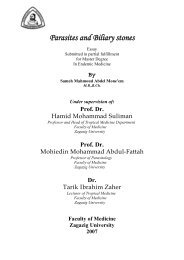J.'.~"";i'
J.'.~"";i'
J.'.~"";i'
You also want an ePaper? Increase the reach of your titles
YUMPU automatically turns print PDFs into web optimized ePapers that Google loves.
Proteinuria and microalbuminuria :<br />
Review ofLiterature<br />
The most recent classification ofpreeclampsia require proteinuria<br />
(defined by excretion of 300mg or greater in 24hour urine specimens; this<br />
usually correlates with 30mg/dL on random sampling (O'Brien, 1992) .<br />
Micro-albuminuria 24 urinary albumin excretion> 30mg/L<br />
(30uglm) might become a clinical tool for predicting pre-eclampsia.<br />
Das et at, (1996), Lopez-Espinoza et al., (1986) found that<br />
proteinuric pre-eclampsia was not preceded by a phase of increasing<br />
albumin loss which could be detected by sensitive radio-immune assay<br />
techniques.<br />
Weight Gain:<br />
A sudden increase in weight may precede the development of<br />
preeclampsia, and indeed , excessive weight gain in some women is the<br />
first sign. A weight increase of about 1 pound per week is normal, but<br />
when weight gain exceeds more than 2 pounds in any given week, or 6<br />
pounds in a month, developing preeclampsia should be suspected, the<br />
suddenness of excessive weight gain is characteristic ofpreeclampsia<br />
rather than an increase distributed throughout gestation. Such a weight<br />
gain due almost entirely to abnormal fluid retention and is usually<br />
demonstrable before visible signs of non-dependent edema, such as<br />
swollen eyelids and puffy fingers. In cases of fulminating preeclampsia.<br />
Or eclampsia, fluid retention may be extreme and in these women, a<br />
weight gain of 10 or more is not unusual. The total weight gained during<br />
pregnancy, however, probably has no relation to preeclampsia unless a<br />
large component ofthe gain is edema. Stringent restriction ofweight gain<br />
is more likely to be detrimental rather than beneficial to both mother and<br />
fetus (Cunningham et al., 1994).<br />
40<br />
-...<br />
:....:...<br />
"'
















